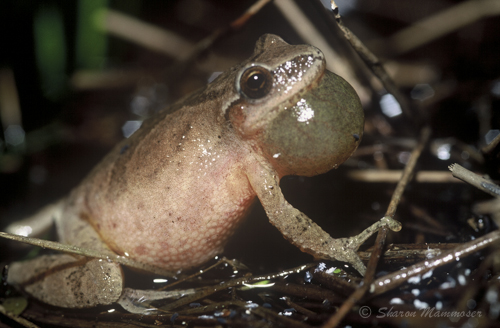 You may have never seen a spring peeper but you have likely heard their loud, bell-like calls that echo through the forest on warm spring evenings. Here are some things you may not know about these wonderful little amphibians:
You may have never seen a spring peeper but you have likely heard their loud, bell-like calls that echo through the forest on warm spring evenings. Here are some things you may not know about these wonderful little amphibians:
1. It is the males who make the high-pitched, bell-like sounds from wetlands throughout eastern and central United States and Canada. They make their songs by filling a vocal sac in their throats with air, like a balloon, and then letting out the air to create a peep as the sac shrinks. 
2 Their chirps can be heard up to a half mile away! They make these calls to attract the females. The faster they chirp, the more attractive they appear.
3. Spring peepers are tiny! Only about an inch and a half long, they can easily fit on the end of one’s finger. Shades of brown, tan and olive, with a distinctive X on their backs, they are nearly impossible to see on the forest floor where they spend most of their time. This explains why few people ever see them!
4. After mating, the females will lay from 750 to 1200 eggs. These will be attached to sticks or leaves in the pond. Depending on the water temperature they may hatch into tadpoles in as little as 4 days. In water with colder temperatures they may take as long as two weeks to hatch.
5. The tadpoles will reach full size in 2 to 3 months and will then leave the ponds to live in the surrounding forest and grassy lowlands. They are eaten by many animals including birds, snakes, skunks and larger frogs.
6. Like other tree frogs, spring peepers have enlarged toe pads for climbing. If you’ve ever watched one jump, you know they seem to “stick” to whatever surface they land on, including smooth surfaces that seem impossible to grip.
7. Adult peepers feed on a variety of invertebrates from spiders, to mites and ticks, ants, caterpillars and other small prey. Tadpoles feed on algae.
8. During the winter, these frogs hibernate beneath logs, in soft mud or under tree bark. They have an anti-freeze-like substance in their bodies which allows them to withstand freezing temperatures for long periods of time.
9. Their latin name is Pseudacris crucifer. Pseudacris means “false locust.” This comes from the fact that their high-pitched calls are often confused with sounds from insects. Crucifer is from the cross or X on their backs.
10 This is what they sound like!
From Lang Elliot of Nature Sound Studio.


2 thoughts on “10 Things You Didn’t Know about Spring Peepers”
Comments are closed.